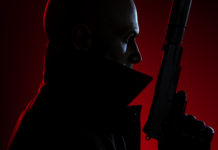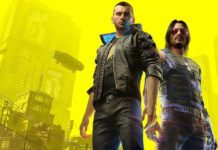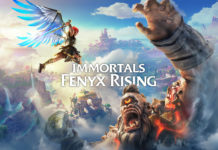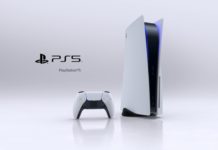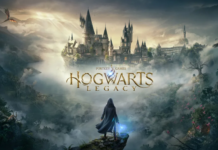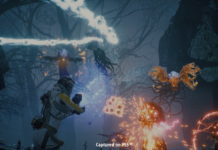genre to crack. Once ruled by Mario, Sonic, and Crash Bandicoot, the genre has
had its share of ridiculous knock-offs. Anyone remember a little game called
Glover? How about Croc, or the often talked about (but not really loved)
Pandemonium?
Even
the good ones couldn’t make a name for themselves. Klonoa and Jumping Flash
are two of the PSone’s best titles, yet only a handful of people know, let
alone care, that they exist.
Having been in the third
dimension for over 10 years, action/adventures just aren’t that exciting
anymore – on game consoles. On handhelds, however, they’re a much newer
experience. Looking back on what developers did for 2D on the Game Boy
Advance, it’s only natural to expect equally good things from 3D games on the
PSP and Nintendo DS.

Death Jr. II: Root of
Evil takes a shot at being one of those memorable, groundbreaking games. It
dares to be different, having a darker tone and more violent gameplay than
most. The weapons are true weapons, loaded with ammo and targeted directly at
your vicious adversaries. Water guns and vacuums – you won’t find any of that
nonsense here. But you will get to wield two pistols, set enemies on fire, and
blast them away with a shotgun, Tommy gun, or rocket launcher.
In Open Season, Boog and
Elliot playfully throw rabbits to stun enemies and trigger switches. In Root
of Evil, you’ll use hamsters as deadly explosives. C4 – the favorite explosive
of many Metal Gear Solid fans – is strapped to the back of hamsters before
they’re let loose on your enemies. The hamster runs as fast as he can, seeking
out the nearest enemy, and will explode as soon as he makes contact.
These weapons are just a
portion of Death Jr.’s darker, semi-comedic antics, all of which are geared
toward that illusive teen and young adult market that grew up with
action/adventures but have since left them behind in favor of more viable
franchises. (Fewer Mario sequels and lower-quality Crash, Spyro, and Sonic
sequels have caused many to lose interest.) The story also reaches out to an
older audience, starting with an amusing sequence of a grim-looking fellow at
a fast food restaurant. He wants the usual artery-clogging materials, despite
the fact that he doesn’t have any arteries (or skin, for that matter – just
bones). His gray skies darken when he, having realized the world is in danger
once more, has to leave the restaurant to call upon the services of DJ and
Pandora.

You pick one of the two
anti-heroes just before the quest begins. Afterward, you’re set free in a
world not unlike The Nightmare Before Christmas. The worlds are eerie and
dreary. Every day looks like Halloween. Giant, man-eating plants stand guard
at scenario entry points, while combative mushrooms litter the waterways (a
nod to the plumber brothers, perhaps?). Colors are generally limited to
various shades of gray, dark red, and black. Fiery lands – usually looked upon
as a place of light – are kept in the game’s decidedly evil state with dark
shades of orange and purple.
Anti-hero #1: DJ
Life sucks when you’re
the kid of a wanted mob boss. Fortunately for DJ, his dad went into a more
ethical profession: he’s the Grim Reaper. The hungry skeleton in the intro –
that’s him. He’s taken captive by a character that could be described as a
she-man Green Giant. I would have expected him to offer me some canned goods
had he not spoken with such an effeminate voice.
DJ comes pre-equipped
with a freshly sharpened scythe, the perfect enemy-slicing weapon that doubles
as a tree-remover. In between platform jumping, vine sliding, and hook
swinging, DJ will have to cut down a few trees that block his progress. Though
his actions may seem damaging, there’s no need to call an environmental group
– it’s just polygons.
Knowing the value of a
good weapon when he sees one, DJ can pick up and use a small selection of
weapons: Icer (freeze and shatter enemies), Proximity Gas Mine (a deadly
trap), and the self-explanatory Electric Gun. DJ also has access to the
aforementioned shotgun, rocket launcher, flame launcher, and C4 Hamster.

Anti-hero #2: Pandora
What’s inside her box? An
arsenal including non-stop destruction (Tommy Gun), explosive ice (Freeze
Gun), a deadly booby-trap (Shiny Sparkles), and a burning sensation that no
enemy can deny (Flamethrower).
Pandora’s weapon of
choice is a whip. It whacks enemies with different animations, but the attacks
and combo results are typically the same. Like DJ, Pandora can swing from
mysterious hooks that appear for no reason. She can spin her whip quickly to
hover over great distances (DJ can do the same with his scythe). Both
characters will use their respective weapons to launch themselves up to
platforms that would otherwise be too hard to reach.
Through the Cracks
Death Jr. II had the
makings of a hit: two characters, new worlds, and an entertaining story. The
story lives up to its promise of delivering something creepy, humorous, and
different. The rest, however, does not meet expectations. DJ and Pandora start
out feeling as smooth and responsive as any platform leader, but quickly
become an uncomfortable mix of button confusion and camera management.
Swinging, jumping, and gliding – three elements that should be second nature
to nearly everyone – do not come across very well. I’ve played every
action/adventure I could get my hands on since 1989. It doesn’t take me long
to get used to a game’s controls when they’re done right.

It’s hard to judge which
is the bigger problem: the fumbling controls or awkward stages. The world
design, though clever in its look and presentation, is very dull. You’re stuck
following a linear path, with exciting moments being a rare occurrence. Many
of the platforms look the same. The screwy camera angles and bland colors can
hinder your judgment, as can your lack of ability to press exactly the right
button at just the right moment. I wasn’t looking for simplicity. But this is
an action/adventure meets third-person shooting. The adventure moments aren’t
all that adventurous – but shouldn’t action and shooting have prevailed?
|
|
Gameplay: 6
Death strikes
twice in Jr.’s first sequel, but the result is not a game that’s twice as
engaging. Action, platforming, running ‘n’ gunning – that’s all good in
theory. The culmination of each element, however, is not that spectacular.
Graphics: 6
Death Jr. II’s
interesting worlds are shot down by weird pop-up and fade-in effects.
Sound: 7.9
Upper-tier
voice-overs from a more professional group of actors and voice directors. The
dialogue isn’t always funny, but at least it sounds good. Musically the game
is missing a few beats, opting for a less potent soundtrack.
Difficulty: Easy/Medium
Either easy or
frustrating. Death Jr. II fails to capture an element of challenge.
Concept: 8
An
action-adventure / third-person shooter combo meets the Grim Reaper and his
son. Original, just not very effective.
Multiplayer: 6
Two-player co-op
lets you and a friend finish the game together (assuming both players have the
patience to stick it out).
Overall: 6
Death Jr. II is
essentially a kiddie game designed for an older audience – as if Crash
Bandicoot picked up a machinegun and decided to shoot up the place.
Unfortunately, when it comes to adult content, games tend to fall asleep at
the wheel. You can’t make a choppy action/adventure, darken the imagery, add a
less childish lead character, and expect players to come running.

